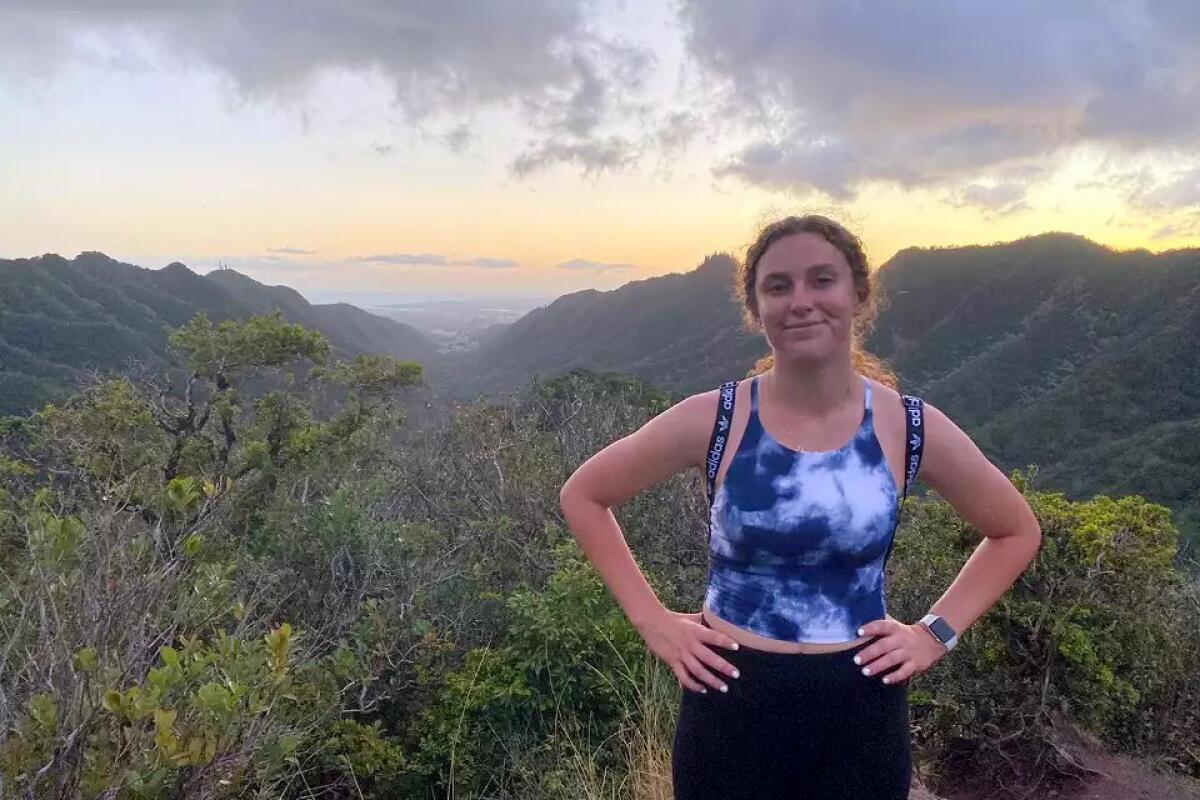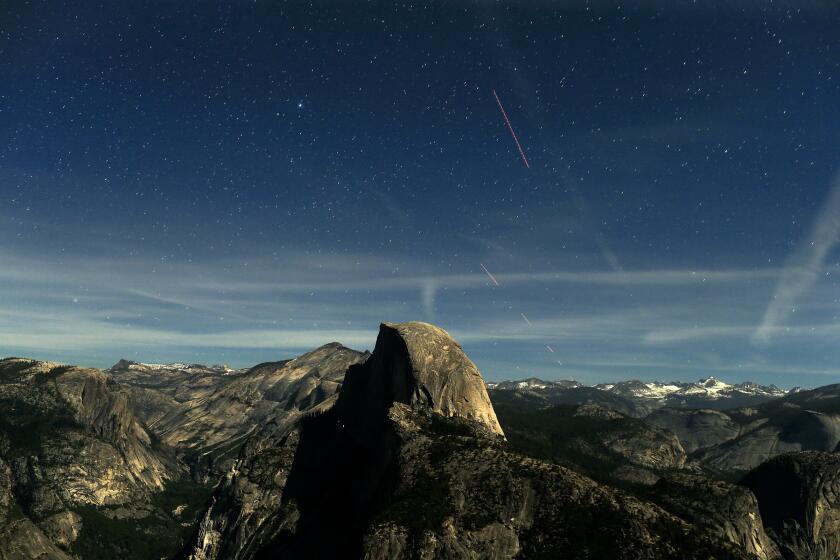He saw his daughter fall from Half Dome. He says safety changes could prevent more tragedies

- Share via
Grace Rohloff was an athlete who had traversed precariously narrow trails leading up to Angels Landing in Zion National Park, hiked the Grand Canyon and trekked across mountains in Sedona. Her dad, Jonathan Rohloff, was often by her side.
Half Dome in Yosemite National Park had been a bucket list hike for the pair.
Rohloff was excited when she secured permits through the national park’s lottery system for her and her father to hike the roughly 16-mile trek to the summit on July 13. But what was supposed to be a fun adventure took a devastating turn when she lost her footing on the cable suspension system that leads from the trail to the summit and fell roughly 200 feet down the mountain.

Officials told her father she probably died instantly.
“Every moment of her life she lived to the fullest,” Jonathan Rohloff said. “People called her Superwoman and that’s just who she was. She was amazing, and when she put her mind to something there wasn’t anyone who was going to tell her no or stop her.”
The 20-year-old’s death, which was first reported by SFGATE, has renewed concerns about the safety of hiking Half Dome, where at least 10 people have died in the last decade. The majority of those fatalities happened as hikers were navigating the cables. In many cases, the sheer granite surface was slick from rain when people fell.
The flight instructor’s rescue of the injured hiker on Sept. 2 earned the praise last week of his Air Force base, which called him an ‘everyday hero.’
Jonathan Rohloff is pushing for safety improvements to the cables, which he believes could have saved his daughter’s life.
The current cable system has wood planks roughly every 10 feet; between the planks, hikers have to traverse smooth granite that can become slick with just a little bit of moisture. Jonathan Rohloff described it as being as “smooth as a countertop.” Metal cables run between poles that have been secured into the rock.
Jonathan Rohloff said the cable system could be reconfigured in a style similar to a suspension bridge, with wood planks placed 6 inches or a foot apart to provide hikers with something to step on besides smooth rock. A second set of cables and climbing harnesses could add another layer of protection, he said.
“Until you get there you don’t realize how steep it is and how much more dangerous the cables are than some of the other places we’ve hiked,” he said. “It just seems unnecessarily dangerous. ... I’ve done so many hikes in so many places, and that one just seems like they could easily put more reinforcements.”
Angels Landing in Utah, which is considered one of the most dangerous hikes in the country, has steps built into the rocks and better cabling, he said.
Yosemite National Park officials did not return a phone call seeking comment this week.
Given Half Dome’s incredibly steep topography and smooth climbing surface, summiting was for years considered an impossible feat, said Michael Ghiglieri, who co-authored “Off the Wall: Death in Yosemite,” a book that chronicles the history of deaths in the national park.
In 1919, the Sierra Club installed the first cables along the 400-foot final ascent so visitors who lack rock-climbing experience could ascend to the summit. The cables were replaced in the 1980s, and in 2012, the cables and trail were listed in the National Register of Historic Places.
Ghiglieri said climbing to the summit can be treacherous, and he fears that the cables provide people with a false sense of security.
Vickie Mates, a former park ranger at Yosemite, acknowledges the dangers in a video posted on the national park’s website specifically about hiking Half Dome. The cables, which are in place from late May to early October, are “not for the out of shape or the faint of heart,” she said.
“They’re vertical, they’re exposed and surprisingly much harder to go down than they are to go up,” she said. “It is extremely dangerous to use the cables during storms even when it’s just raining lightly.”
James Hall’s family said he was trying to save Monica Ledesma in Angel Falls when they both died last week.
Jonathan Rohloff said that despite the challenging nature of the hike, he never anticipated his daughter would lose her life on Half Dome. She was an athlete who played club basketball, sprinted and did shot put and discus while on the track and field team in high school. She set the school record for her javelin throw, he said.
Grace Rohloff had seemingly endless energy, juggling a heavy course load at Arizona State University so she could graduate early and become a math teacher. During the day she worked as an aide for a girl with Down syndrome, and at night she was a barista at Dutch Bros., her father said.
In her free time, he said, she was always outside.
She hiked the Grand Canyon solo in just a few hours recently because she had a day off work in the middle of the week, and she completed the journey up to Angels Landing in the snow, her dad said.
The Rohloffs had made their way to the top of Half Dome by the early afternoon and were taking in the sweeping views of Yosemite Valley when they heard the crack of thunder. With dark clouds rolling in, they knew they had to get off the rock quickly, he said. Lightning strikes are not uncommon on Half Dome during storms.
The forecast they had checked earlier predicted clear skies, but it soon began pouring rain as they descended the cables.
But the cables, which are narrow, were congested with people also trying to leave. As they traversed down the rock, Grace Rohloff’s shoes started slipping. She was wearing hiking boots that were supposed to provide good grip, but the granite was slick, her father said.
“Dad, it’s really slippery,” Jonathan Rohloff recalls his daughter telling him. The young woman was extremely brave by nature, but he could tell she was getting nervous.
“I told her let’s just take it one section at a time. Let’s do it together. I’m right here with you,” he said.
An ultra-runner was near the end of a 50-mile trek when he had a close encounter in Yosemite Valley with a very big black bear.
About three-quarters of the way down the cables, both of Grace Rohloff’s feet went out from under her and she slid down the mountain. For roughly three hours he waited with a park ranger until search and rescue could reach his daughter.
He shouted down to her that he wasn’t leaving and that people were on their way to help her. She just needed to hold on. He yelled that he loved her.
Some hikers stopped and asked if they could pray with him.
“What happened to Grace doesn’t have to happen to anyone else,” he said. “They can put in a system on the cables to make it so much safer. Grace would want that.”
More to Read
Sign up for Essential California
The most important California stories and recommendations in your inbox every morning.
You may occasionally receive promotional content from the Los Angeles Times.














